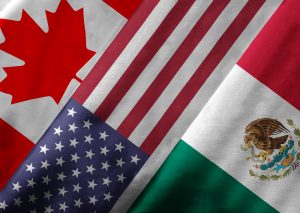 The North American Free Trade Agreement (NAFTA) has been an ongoing issue since President Donald Trump took office. He has been clear about his distaste for NAFTA and the aspects of the agreement that allow for unfair trade practices.
The North American Free Trade Agreement (NAFTA) has been an ongoing issue since President Donald Trump took office. He has been clear about his distaste for NAFTA and the aspects of the agreement that allow for unfair trade practices.
In 1994, NAFTA went into effect under the Clinton administration. The idea that came about in the 1980s under President Reagan that allowed free trade between the United States, Canada and Mexico came with two main goals: to expand North American trade and to make these countries more competitive in the global marketplace.
The agreement has seen some success since it was put in place. It has increased North America’s competitiveness in the global marketplace and tremendously boosted trade. It also lowered prices on commodities such as oil and produce. However, there have been costs to those successes, especially within the U.S. specialty crop industry. Although the agreement lowered prices for produce, it heavily decreased the demand for American agricultural commodities, forcing some farmers around the country to either sell their land or test different crops that may sell.
NAFTA renegotiation talks began in August 2017. The original goal was to complete renegotiation by the end of March 2018, due to the Mexican presidential election that occurs in July. However, negotiations continue.
John VanSickle, a professor in the University of Florida’s Food and Resource Economics Department, said there is a lot of uncertainty surrounding NAFTA renegotiation talks.
The seventh round of talks ended at the beginning of March. According to VanSickle, there was an eighth round of renegotiation talks scheduled for April 8–18 in Washington, D.C., but it was canceled due to the Summit of Americas, which took place in Lima, Peru, April 13–14. President Trump was hoping to speak with ministers from Mexico and Canada during the Summit. However, there has been no word as to if that meeting ever took place.
“It got quiet, and quiet tells me there’s probably a realization that we’re still a long way from making some kind of agreement on negotiation,” VanSickle said.
To date, trade representatives from the United States, Canada and Mexico have negotiated six of the 30 chapters that make up NAFTA. “They have a lot of tough work ahead of them,” VanSickle said.
It took a long time to negotiate the original NAFTA, so modernizing the agreement will not be a quick task, pointed out VanSickle. The representatives would like to fit in some of the current issues that stand out, or in other words, rebalance the agreement. “They (the representatives) want to take back some of the trade that has been lost in certain sectors,” VanSickle explained.
President Trump has threatened to pull out of NAFTA altogether on numerous occasions. Although this has not come to fruition, VanSickle believes nothing is off the table with Trump. “Obviously he has the ability to take us out of the agreement if that’s what he chooses to do,” VanSickle said. “He’s not afraid to take those bold steps if that’s what he thinks it would take to reach an agreement that’s more favorable to the United States.”
VanSickle said President Trump and U.S. Trade Representative Robert Lighthizer would like to complete renegotiation talks by the U.S. mid-term elections in November. However, VanSickle is not certain that new goal will be met successfully.
Share this Post









